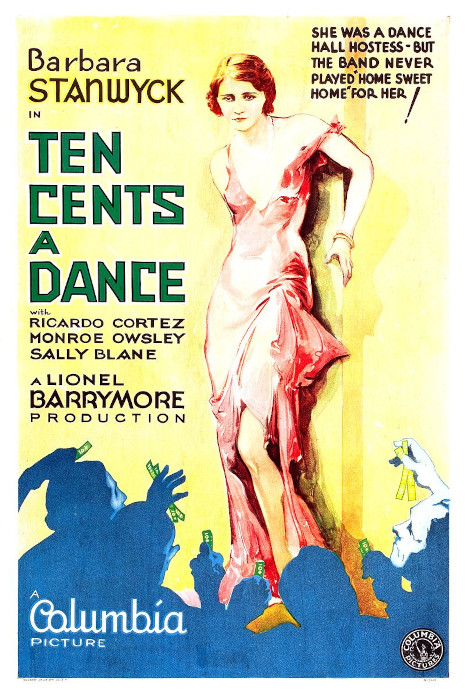Sailor: “What’s a guy gotta do to dance with you girls?”
Barbara: “All you need is a ticket and some courage.”
It’s intriguing to think how time tends to shrink an actors or directors filmography. . . the passing years seeming to erase movies (be them lesser, unrelatable to present viewpoints, simply lost to time, or so on). For instance, Lionel Barrymore – once one of the biggest stars in Hollywood, a two time Academy Award nominee (and one time winner), is mostly known for his cantankerous and utterly realistic portrayal of villainy as Mr. Potter in the Frank Capra Christmas classic It’s a Wonderful Life. In actuality, he has an impressive 217 acting credits to his name, while many may not even know that he was also a director. . . today’s film his fourteenth and final credited effort – Ten Cents a Dance (1931).
A title pulled from a popular 1930 song of the same name (written by Richard Rodgers, lyrics by Lorenz Hart, originally sung by Ruth Etting), the playful, jazzy romp sways over both the opening credits as well as when the screen turns black at the end of the film. A tune lamenting the work of a taxi dancer, that is, a girl hired to shimmy with libidinous men at a happening nightclub for ten cents a dance, poor Barbara O’Neill (Barbara Stanwyck) is our titular character. For film fans, something immediately evident is that there is already a piece of her most famous character, Phyllis Dietrichson from Double Indemnity, raring to come out. She’s bold, blunt, and brash, or brunette, bad, and beautiful – whichever 3Bs you prefer, a no nonsense dancer who does it her way. . . much to the chagrin of the dowager in charge of the ladies, Mrs. Blanchard (Blanche Friderici).
Pursued by rich socialite Bradley Carlton (Ricardo Cortez) – equipped with charming pencil mustache and plenty of gifts (including a hundred dollar tip), a triangle is created when Barbara feels sorry for poor sap and boarding house roommate Eddie Miller (Monroe Owsley) – a bumbling guy who has already been eaten up and spit out in just a few short weeks in New York City.
Softening her heart, she gives the C-note to him. . . also putting in a good word for him with Carlton, who gifts him a job despite having no true skills or confidence. Soon, Barbara’s breaking the rich man’s heart, marrying Eddie instead (though he insists on keeping the whole thing secret – not only from his new boss, but from everybody).
Of course, this should be a red flag. Soon after the marriage, Eddie seems to become much more frustrated, even angry, with their lot in life, and begins keeping rather irregular hours (but don’t call the office to check on this, he tells his wife. . . after all, he doesn’t want anyone knowing they’re married). What’s he really doing? Well, he’s met an old rich friend, Ralph Clark (David Newell), and his now grown sister Nancy (Martha Sleeper). Partying with the rich, his constant lies about his marriage allow him to date the wealthy woman. . . living well beyond his means. Furthermore, he begins investing their money, and later stealing more from Carlton’s company, to play the stock market with some illegal tips from his old buddy. Leading to a rather sticky situation, what will become of this unusual marriage? How might the third wheel, Mr. Carlton, play a role in its solution? And can a taxi dancer ever just catch a break?
Centered on Stanwyck’s solid performance, she is hard-boiled, cynical, and harsh, but somehow balances that with a matriarchal passion and charm. One of the true spectacles of Pre-Code cinema (check out my review of 1933’s Baby Face for another prime example), her character really goes through quite the transformation, at first hard shelled. . . her edges soften, marriage allowing those dance hall defenses to fade away. In lesser hands, it likely wouldn’t be as believable, for as things worsen as the narrative drives toward its conclusion, she must live by way of her wits once more (that hardening returning). . . a true roller-coaster ride of a performance.
Though not as racy as many other Pre-Code features, Ten Cents a Dance is still fun fare. You can see how, at the time, it held some controversy – the dance hall full of sex-crazed sailors and single men, the affairs on the side, the embezzlement, and so on, all giving this a bit of a sharpened edge. Plus, the narrative rings so very true to the struggles of people during the Great Depression – after all, many would have been in a similar position to the married couple found at the heart of this story. So, pay your ten cent fee and join this dance, that’s the only way you’ll find out if the fox trots off happily ever after, or if that dreaded married male swinger wins.



